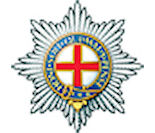Coldstream Guards
  |
Battalions |
Formed in 1650 as part of the New Model Army during the English Civil War, the regiment swore allegiance to King Charles II in 1660 and has guarded the country's monarchs since. As part of their duties, the Coldstream Guards also contribute to world-famous ceremonial occasions, such as Changing of the Guard and Trooping the Colour and are distinctive for the black bearskin caps and red tunics worn by the five regiments of the Foot Guards.
The regiment epitomises the British Army's values and standards: selfless commitment, respect for others, loyalty, integrity, discipline and courage. Drawing strength from its heritage to face the challenges of the future, the Regiment lives by its motto, 'Nulli Secundus' or 'Second to None'. The primary role of the Coldstream Guards is as light role infantry, capable of deploying anywhere in the world at short notice to conduct any task. Conventional warfare, counter-insurgency, peace support and 'hearts and minds' civil aid tasks are all part of the Regiment's demanding daily regime.
The regiment has three core elements
- 1st Battalion: The elite light role infantry unit of 600 men
- Number 7 Company: The ceremonial company of 100 men, based in Wellington Barracks, London
- The Regimental Band of the Coldstream Guards: The world-famous military marching band
The earliest service which the Regiment can claim against a foreign power was in 1652, under Colonel Monck, who as one of 3 Admirals led the British Fleet with conspicuous success against the formidable Dutch Navy. The connection with the sea was furthered in 1664 when 500 men from the Regiment were raised by Royal Warrant for sea service, forming the Royal Marines. The Regiment first mustered in 1650 near Berwick comprising five of Sir Arthur Hazelrigg's companies from Newcastle and five of Colonel Fenwick's companies from Berwick. The new Regiment was officially known as Monck's Regiment of Foot, and soon marched into Scotland and fought with distinction at the Battle of Dunbar on 3 September 1650.
Coldstream is a parish in Berwickshire, lying about the middle of the district of the Merse, on the northern bank of the Tweed, where that river begins to be the border boundary, having Ladykirk and Swinton on the north, and Eccles on the west; extending seven or eight miles along the Tweed, and being four in breadth. This was once among the best cultivated and productive parishes in Scotland ; well enclosed and planted.
Coldstream is a town in this parish, standing upon the north bank of the Tweed, having the rivulet called the Leet flowing past it on its western quarter. It is nearly nine miles east from Kelso, and fourteen west from Berwick. It was a thriving irregularly-built town, quite Scottish in its appearance, notwithstanding its proximity to England. It formerly derived importance from a ford on the Tweed, the first of any importance which occurs in traversing the stream upwards from Berwick. By this passage, Edward I entered Scotland with his overpowering host in 1296. Many other Scottish and English armies, before the union of the Crowns, made their way by this passage, to ravage the country of their respective enemies. It was last used by a Scottish army, as an entrance into England, in 1640, when the Covenanters found it necessary to take that extreme measure against Charles I.
General Monck led the Regiment from his headquarters at Coldstream on his historic 1660 march to London. The Regiment were at once ordered to take up their quarters in the precincts of St James's Palace and were ordered by Monck to restore order and repress the riots which had characterised the last months of Parliamentary rule. As the exiled King Charles II returned to London in May that year, the Regiment were inspected by the Sovereign for the first time. His Majesty expressed himself as 'Much struck by the beauty, discipline and martial appearance of the Troops'.
On the King's Restoration, the disbandment of Cromwell's New Model Army was decreed by Act of Parliament, with the reservation that the Captain General's (Monck's) own Regiments of Horse and Foot be retained to the last. By January 1661, the disbandment of the Army was almost complete, save for Monck's Regiment of Foot. On 6 January a serious uprising occurred in London, necessitating the Regiment to be deployed to quash the riots. Following this it was decided to retain the Regiment permanently, for the personal security of the Sovereign. The King, however, already had his own bodyguard which had been formed abroad in 1656 during his exile. This, the First Regiment of Foot Guards, subsequently became the Grenadier Guards.
On 14 February 1661 the Regiment paraded at Tower Hill where they were ordered to ground arms as the Lord General's Regiment of Foot Guards, and immediately take up arms in the name of the King. The Regiment was offered the title of the Second Regiment of Foot Guards, but, being older than the First, refused and instead became The Coldstream Regiment of Foot Guards, to commemorate its march form Coldstream to London. As a result of this, and the Regiment's high standards, the regimental motto is Nulli Secundus (Second to None), but the Regiment takes second place after the Grenadiers in order of seniority and all ranks wear buttons in twos on their tunics.
From 1682 to 1993 the Regiment consisted of two battalions. The 3rd Battalion was formed in 1897 until it was placed into suspended animation in 1959. The 4th Battalion was formed during both world wars, and the 5th and 6th Battalions during World War 2. The 2nd Battalion was placed in suspended animation in 1993, although its colours continue to be borne by No.7 Company, the Regiment's independent incremental company stationed in London.
The 1st Battalion's 2009-2010 tour of Afghanistan on Operation HERRICK 11 was arguably its hardest fought campaign since World War 2. Engagements with the Taliban occurred on a daily basis, but the overarching threat was from improvised explosive devices, which restricted freedom of movement and hampered progress throughout the area of operations. The Battle Group was responsible for introducing the Afghan National Army and Police to its area, and by the end of the tour British troops, Afghan soldiers and Afghan policemen were of equal number across its area. While the 1st Battalion was in Afghanistan, Number 7 Company recreated Monck's historic march from Coldstream to London in 25 days, through deep snow and freezing temperatures in January 2010.
The Regiment has served with distinction in almost every campaign fought by the British Army - in the Peninsula Campaign, at Waterloo, and in both world wars. Every December the Regiment still celebrates its defence of Hougoumont Farm at Waterloo, with a brick from the farm being paraded around barracks by the Sergeants' Mess. In recent years, the Regiment has been deployed to Northern Ireland, the Gulf, Bosnia, Iraq and Afghanistan. Thirteen members of the Regiment have been awarded the Victoria Cross, and one the George Cross.
|
NEWSLETTER
|
| Join the GlobalSecurity.org mailing list |
|
|
|

